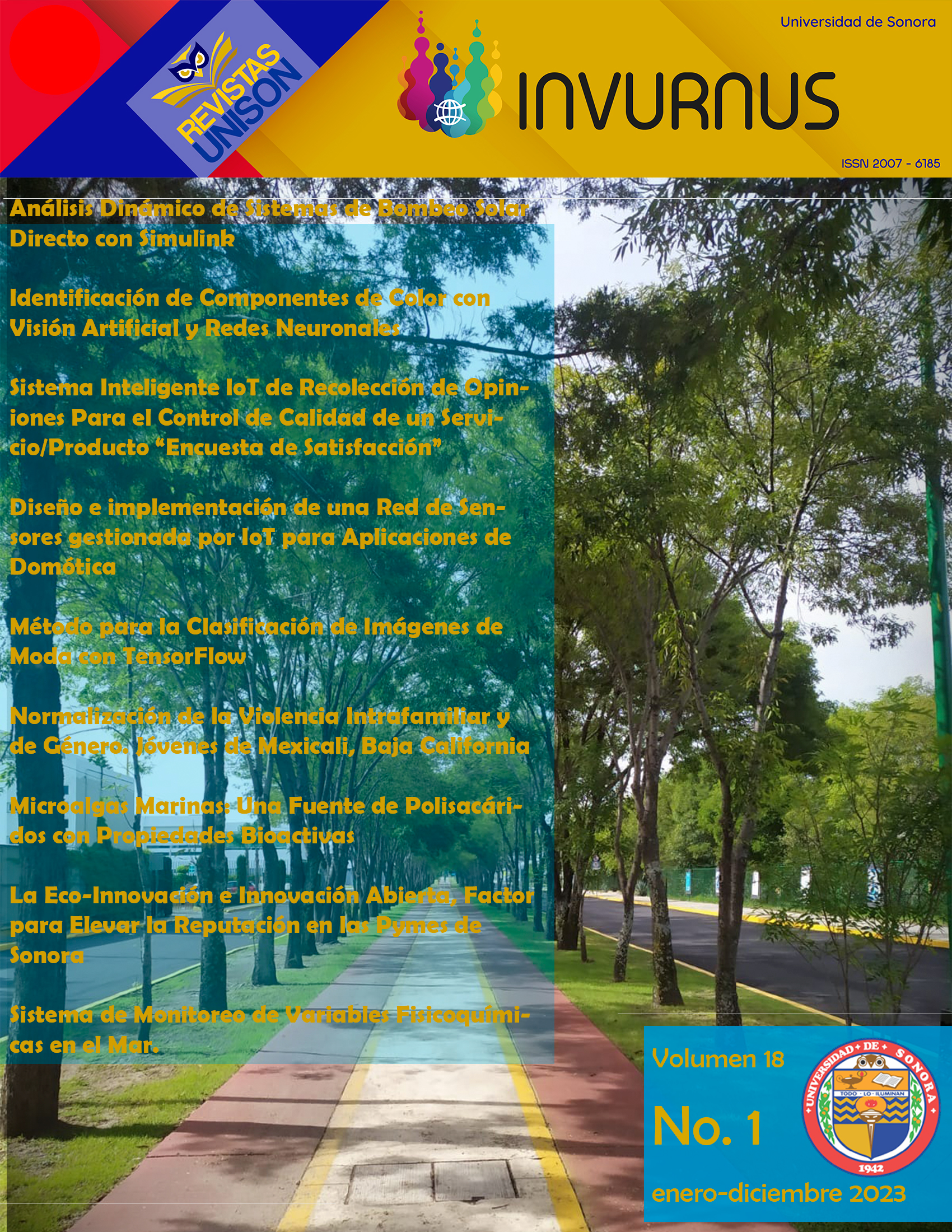Identificación de componentes de color con visión artificial y redes neuronales
DOI:
https://doi.org/10.46588/invurnus.v18i1.79Keywords:
Redes neuronales, proceso, sistema, visión, Redes neuronales, proceso, sistema , visiónAbstract
The present work detects plastic parts of 2 different colors, red and blue, through the use of photographs of the pieces, which are analyzed through an interface written in the Visual C# programming language. A commonly used WEB camera is used as the vision element that provides the information needed by the interface, which has an implementation of a neural network trained with the backpropagation algorithm. To achieve this recognition, the traditional process of taking a series of samples as a training set is followed and the project is validated by implementing it on a production line in a local manufacturing industry. The results obtained will show how efficient the system is using artificial vision techniques to process information and the use of a certain neural network structure as a recognition element.
Downloads
References
http://www.etitudela.com/celula/downloads/visionartificial.pdf
https://www.intel.es/content/www/es/es/manufacturing/what-is-machine-vision.html
Honey characterization using computer vision system and artificial neural networks. 159. Salas, R. (2004). Redes Neuronales Artificiales. Universidad de Valparaiso. Departamento de computacion. 116 Savaktar, D. (2012).
Antsaklis, P. J. (1990). Neural networks for control systems. IEEE Transactions. Galushkin, A. (2007). Neural Networks Theory. Springer.
Gestal Pose, M. (2000). Introduccion a las redes de neuronas artificiales. Departamento de Tecnologías de la Información y las Comunicaciones Universidad de Coruña. Heaton, J. (2008).
Introduction to neural networks for C#. Heaton Research, Inc. Henry A. Rowley, S. B. (1998). Neural Network-Based Face Detection. PAMI. Matich, D. J. (2001).
Redes Neuronales: Conceptos Básicos y Aplicaciones. Informática Aplicada a la Ingeniería de Procesos – Orientación I. Universidad Tecnológica Nacional – Facultad Regional Rosario. Murata, N. Y. (1992).
Network information Criterion - determining the number of hidden units for an artificial neural network model. IEEE. Robert L. Harvey, P. N. (1991).
A Neuronal Network Architecture for General Image Recognition. The Lincoln Laboratory Journal, 4(189). Rocha Miranda, A., & Morales Ramos, J. C. (2004).
Procesamiento digital de señales y redes neuronales. Obtenido de Consultoría y capacitación para la competitividad de clase mundial: http://www.icicm.com/files/ProcDigitalSe_alesRedesNeuronales.doc Rojas, R. (1996).
Neural Networks: A Systematic Introduction. Berlin: Springer. Rosenblatt, F. (1961). Principles of Neurodynamics: Perceptrons and the theory of brain mechanisms. Washington DC: Spartan Books. Sahameh Shafiee, S. M.-C. (2014).
Identification and Classification of Bulk Fruits Images using Artificial Neural Networks. International Journal of engineering and Innovative Technology, 1(3). V. C. Patel, R. W. (1998).
Color Computer Vision and Artificial Neural Networks for Detection of Defects in Poultry Eggs. Artificial Intelligence Review(163-176). Valencia Reyes, M. A. (2007).
Algoritmo Backpropagation para redes nueronales: conceptos y aplicaciones. Instituto Politecnico Nacional. Centro de investigacion en computacion. Velez Serrano, J. F., Moreno Diaz, A. B., Sanchez Calle, A., & Sanchez-Marin, J. L. (2003).
Vision por computador. José Francisco Vélez Serrano. Vision Artificial. (s.f.). Recuperado el 10 de 10 de 2014, de C.I.P. ETI Tudela: www.etitudela.com/celula/downloads/visionartificial.pdf White, H. (1992).
Artificial Neural Networks: Approximation and learning theory. Basil, Blackwell: Oxford. Zadeh, L. A. (1973). Outline of a New Approach to the Analysis of Complex Systems and Decision Processes. 24-44.
Downloads
Published
How to Cite
Issue
Section
License
Copyright (c) 2023

This work is licensed under a Creative Commons Attribution-NonCommercial 4.0 International License.












